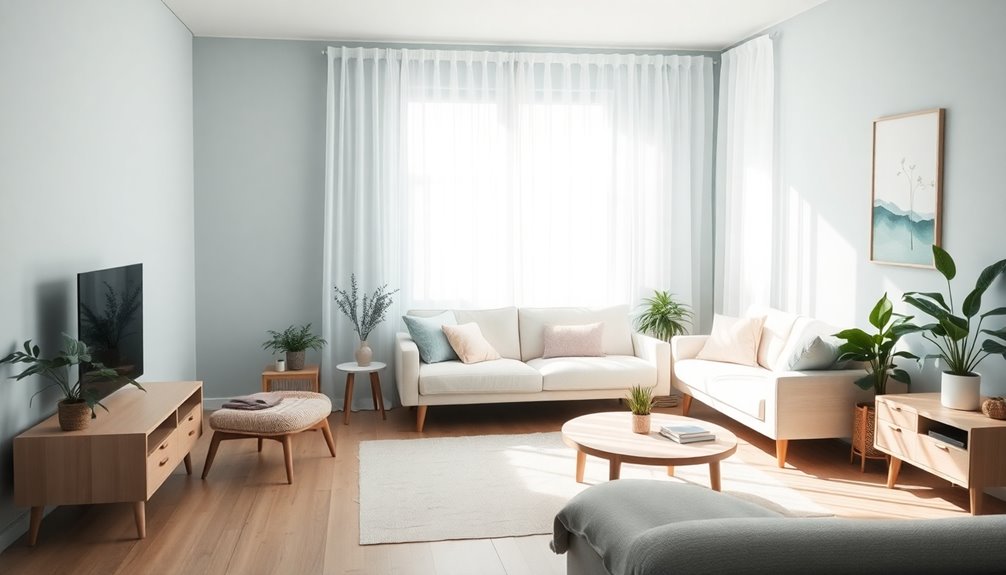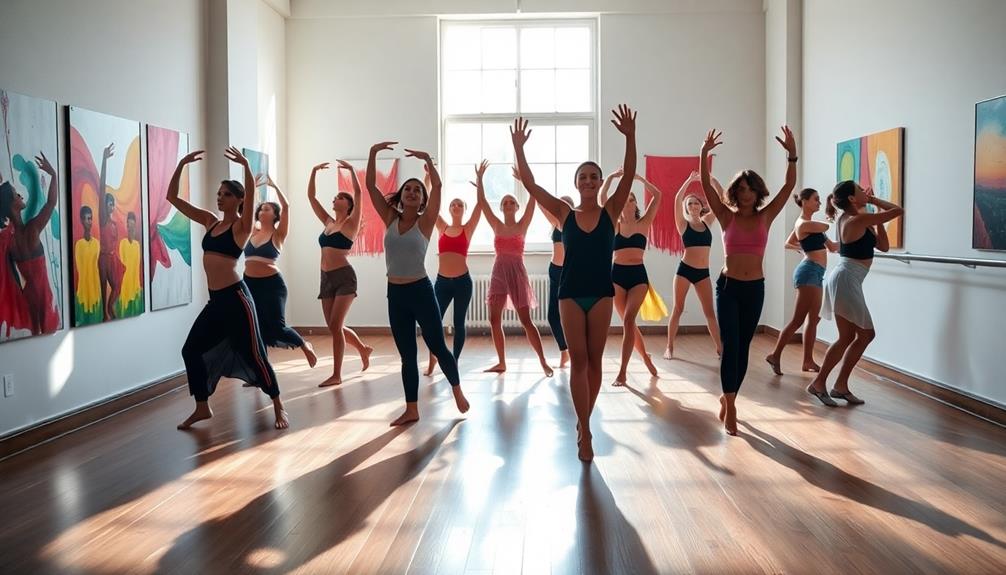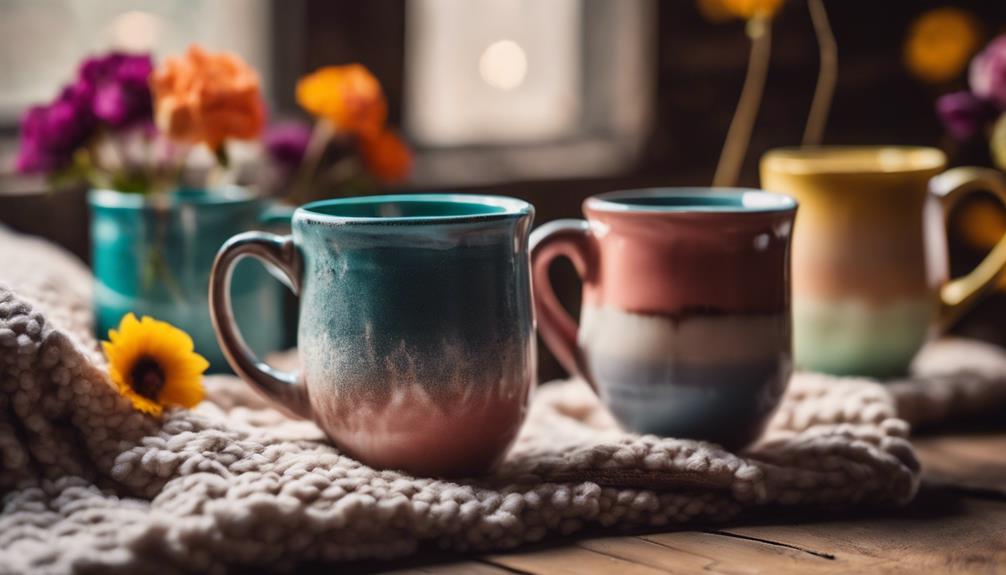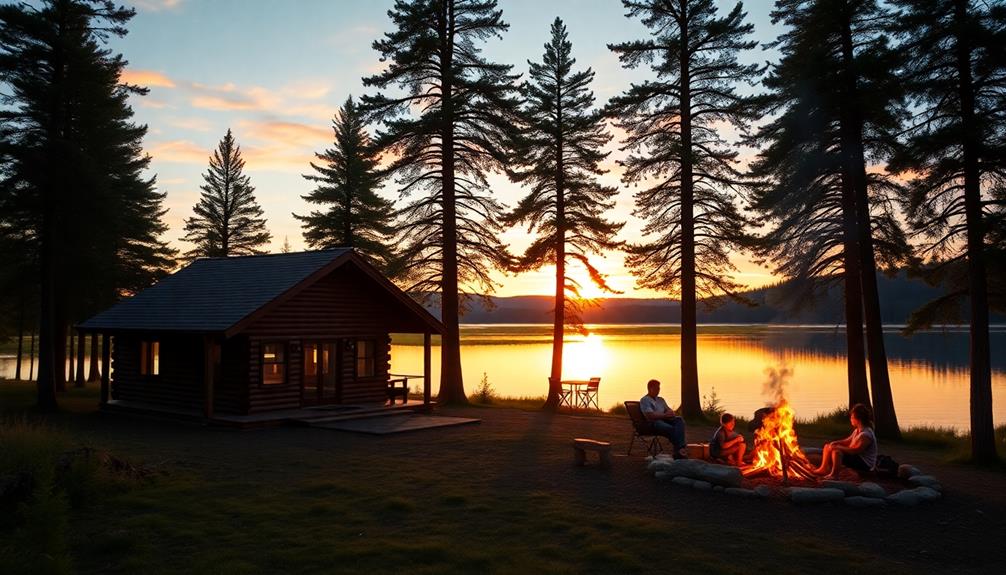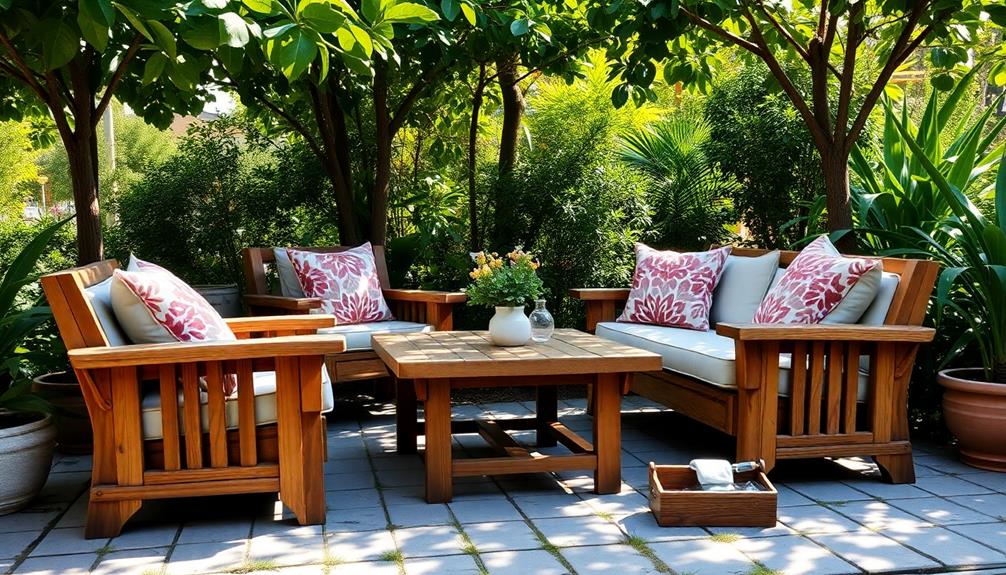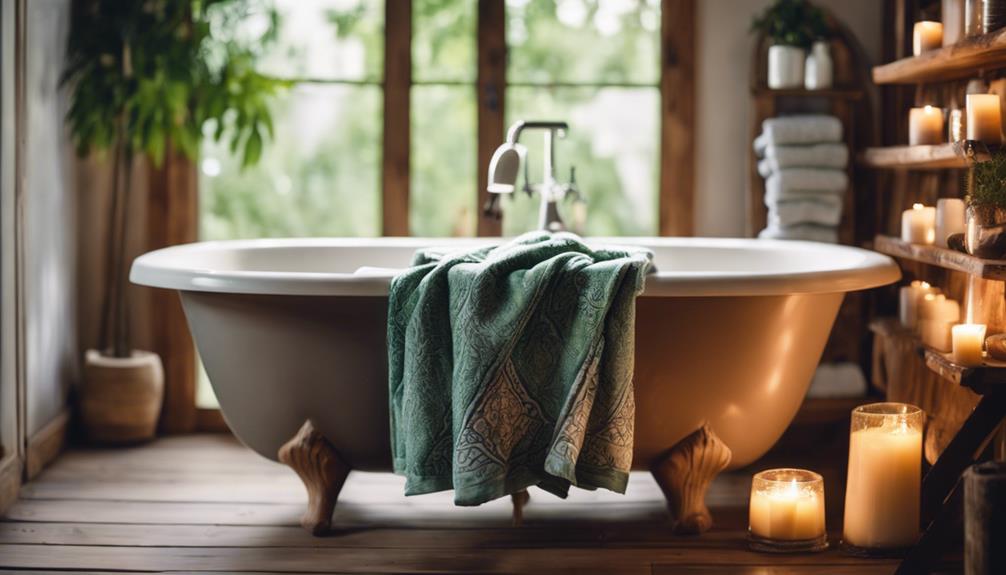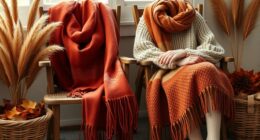Color psychology is essential in Nordic design, guiding you to create calm, inviting spaces. You'll benefit from neutral palettes of whites, grays, and soft pastels that promote tranquility. Incorporating muted blues and greens instills a sense of serenity, while natural light reflects off these colors, enhancing the airy atmosphere. Don't forget to add plants; they refresh your space and connect it to nature. Achieving balance with thoughtful color combinations can significantly influence your mood and well-being. By exploring these principles further, you can transform your home into a peaceful retreat.
Key Takeaways
- Neutral colors like whites and grays promote calmness and spaciousness, creating peaceful atmospheres in Nordic design.
- Muted blues and greens enhance tranquility, fostering serenity and a sense of relaxation within living spaces.
- Soft pastel accents introduce gentle warmth, balancing the environment and preventing monotony in color schemes.
- Natural light is maximized through light colors and large windows, enhancing mood and psychological comfort in interiors.
- Incorporating plants not only purifies air but also connects spaces to nature, promoting a refreshing and invigorating atmosphere.
Color Trends in Nordic Design

When it comes to color trends in Nordic design, you'll find that neutral palettes often take center stage. Whites, grays, and beiges create a calm and open atmosphere, making your spaces feel larger and more inviting.
You can incorporate muted shades of blue and green to introduce color without overwhelming your environment. Soft pastel accents like light pink, baby blue, and pale yellow can bring a gentle touch, enhancing the soothing feel of your room.
Colors in Nordic design are often inspired by the stunning natural landscapes of Scandinavia, allowing you to connect with nature indoors. The monochromatic backdrop of neutral tones allows other design elements, like furniture and art, to stand out beautifully. Additionally, incorporating rounded shapes in your furniture choices can enhance the overall aesthetic and create a welcoming atmosphere.
However, bold and vibrant colors are also making waves in 2024. You might consider using saturated reds as striking accents or exploring various shades of blue, from sky blue to cobalt.
Bright orange and amber tones can add warmth, while lighter purples, like lavender, bring a fresh twist. By mixing these vibrant shades with your neutrals, you can create a dynamic, visually appealing space that reflects your personality.
Psychological Effects of Colors
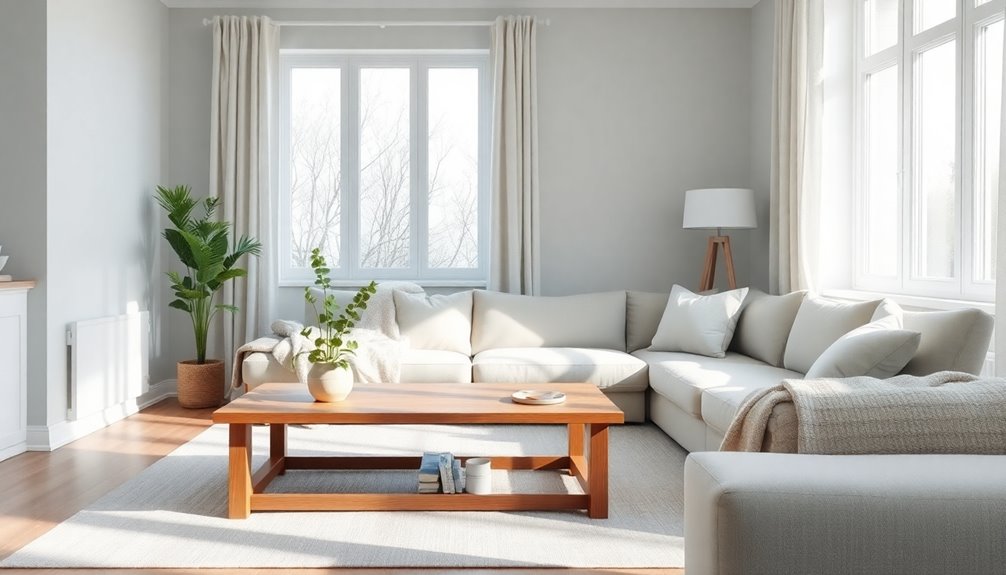
Nordic design not only emphasizes color trends but also taps into the psychological effects that different hues can have on our emotions and well-being.
Neutral colors like white symbolize purity and peace, creating a sense of openness and calm in your space. However, without warmer undertones, they might feel cold or sterile.
Cool colors, particularly blue, promote serenity and reflection. When you incorporate soft, dusky blues, you enhance a calming atmosphere, perfect for intellectual activities. This hue, often linked to water and earth, fosters relaxation, aligning with the historical emphasis on light and bright spaces inherent in Scandinavian design.
Green, on the other hand, refreshes and balances your environment. While it can feel bland if misused, the right context—like with plants—can invigorate your space. Depending on its undertones, green can either energize or soothe.
Maximizing Natural Light
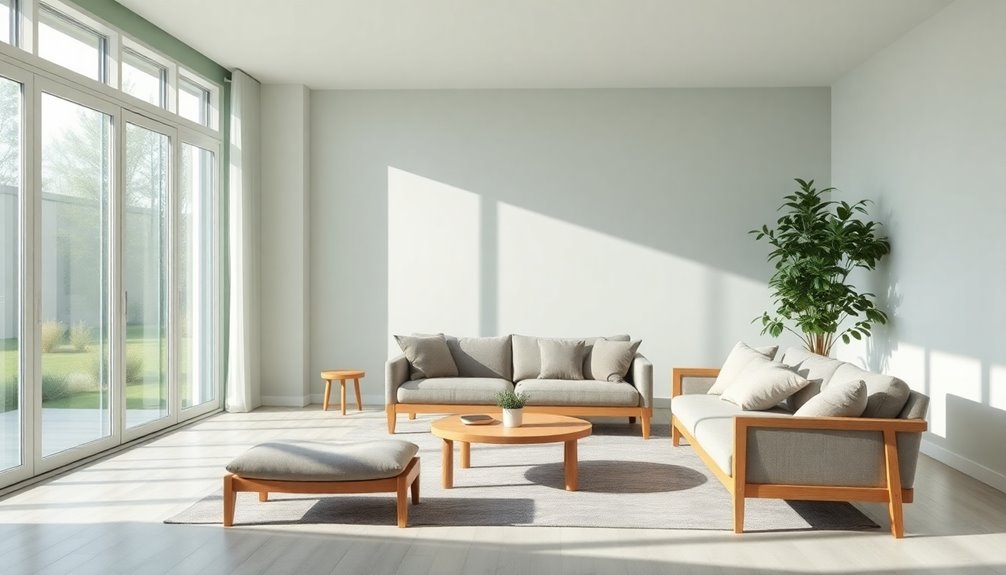
Maximizing natural light is essential in creating a bright and inviting space, especially in Nordic design, where the emphasis is on openness and warmth. To achieve this, opt for light, neutral colors like white, pale grey, or sand for your walls and furnishings. These hues not only reflect light but also create an airy atmosphere.
Incorporating light-colored throws and cushion covers can further brighten darker rooms, enhancing the overall effect. Strategically placing mirrors can also work wonders. Position them opposite or adjacent to windows to bounce light throughout the space. Larger mirrors are particularly effective in dim areas, helping to illuminate kitchens, home offices, and narrow hallways. Additionally, using light-colored wall paint can amplify the brightness, creating an airy feel that complements your decor choices. To further enhance the serene atmosphere you’re aiming for, consider incorporating tranquil spa room design ideas that integrate soft textures and natural elements. This cohesive approach not only optimizes light but also fosters a calming environment perfect for relaxation and rejuvenation.
Glass doors and panels are another great addition, allowing light to filter through and brighten enclosed spaces. Don't forget about your windows—clean them regularly and consider leaving them undressed or using sheer curtains. This maximizes light entry, while light-colored flooring, like pale-stained hardwood or cream rugs, reflects natural light even more. Additionally, bright environments are linked to improved productivity and creativity, making these changes not just aesthetically pleasing but also beneficial for well-being. Furthermore, utilizing energy-efficient heat pumps can help maintain a comfortable temperature while maximizing the benefits of natural light.
Nature's Influence on Design
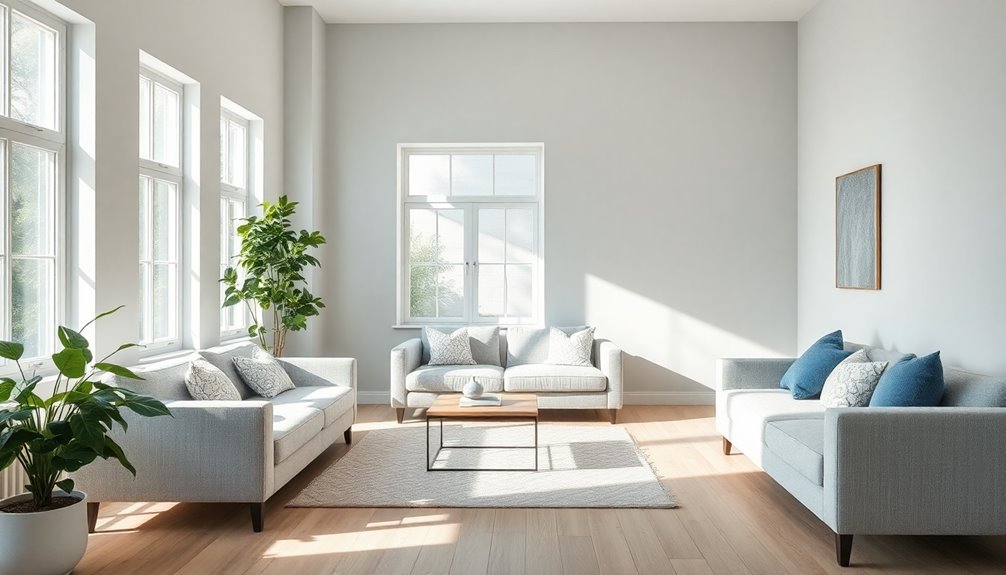
As the connection between design and nature deepens, you'll find that incorporating natural elements into your space fosters a sense of tranquility and warmth.
In Nordic design, wood is a staple material, often in light-colored varieties like birch and pine, which brighten your interiors and create an airy feel. Natural materials such as leather and stone add warmth and texture, enhancing the overall coziness of your environment. The emphasis on natural elements is a defining characteristic of Scandinavian design. Additionally, popular design choices often include weather-resistant materials that ensure durability and functionality in your living space.
The harsh Nordic climate has shaped a design philosophy focused on functionality and simplicity, emphasizing the need for warm, light-filled spaces. Designers often maximize natural light through large windows and light-colored interiors, countering long, dark winters.
This appreciation for sunlight directly influences your choice of materials, like solid hardwood floors and exposed wood grain furniture, which add unique character and visual interest.
Additionally, incorporating natural textures such as linen and wool in your textiles introduces depth and comfort into your home.
Behavioral Color Psychology
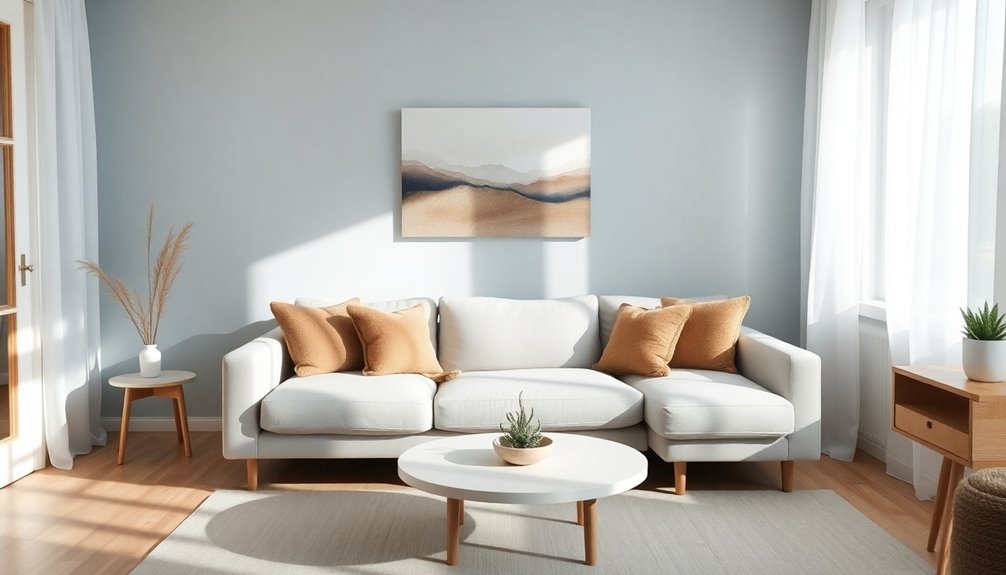
Incorporating natural elements into your space not only fosters tranquility but also sets the stage for understanding how color influences emotions and behaviors.
Colors play a significant role in shaping your mental wellbeing. For instance, blue can evoke a sense of calm, while bright colors like yellow can energize a room. Understanding these associations helps you make informed choices about your environment. Additionally, certain colors can enhance productivity by up to 15% in creative tasks(green enhances creativity) and support overall mental health. Research shows that incorporating hydration support through natural elements can further enhance the calming effects of your space.
Cultural and personal factors also affect how you interpret colors. While white often symbolizes neutrality and calmness, it may have different meanings in other cultures. This nuance can impact your emotional response to the space.
In Nordic design, using nature-inspired colors can combat the gloominess of long winters, uplifting your mood and restoring energy.
Dark colors, on the other hand, might contribute to feelings of sterility and coldness. Designers leverage color psychology to create harmonious interiors that positively influence behaviors and feelings.
Whether you're making design choices for a home or workspace, remember that colors can guide attention and influence decision-making.
Achieving Balanced Color Combinations
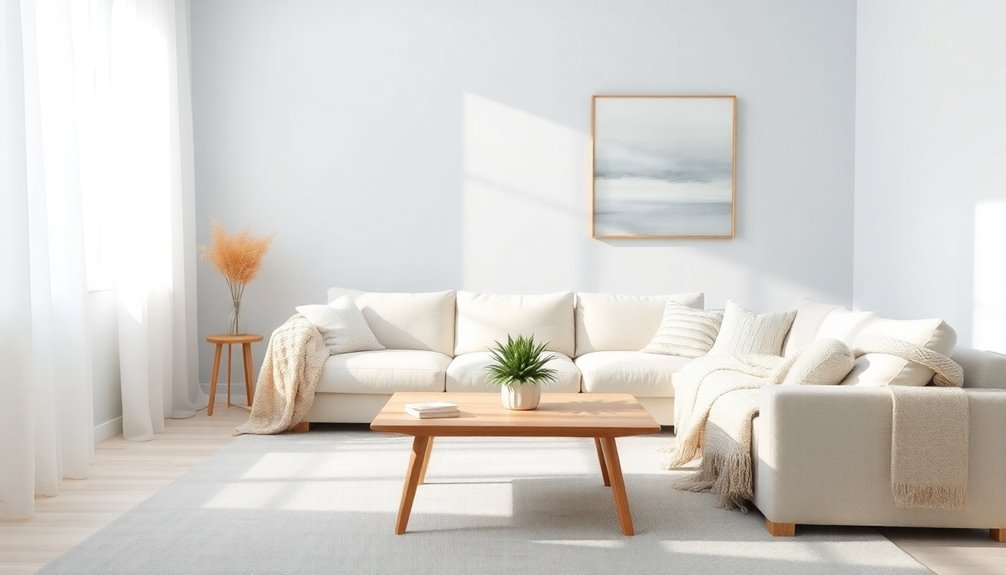
Often, achieving balanced color combinations in your space requires a thoughtful approach to harmonizing various hues. Start by considering the current color trends in Nordic design, which shift every 10 to 15 years. While recent trends lean towards bolder colors like orange, pink, and yellow, integrating these with natural tones can create a refreshing atmosphere.
Utilize neutral colors like white, gray, and beige to ground your palette. These shades not only enhance light but also provide flexibility. You can combine them with brighter accents to avoid monotony while adding visual interest. For instance, pairing deep onyx with vibrant lemon zest or soft pink can create an inviting contrast.
Don't forget the psychological impact of your choices. Use calming colors like blue and green for serene spaces, while warm tones can foster coziness. Additionally, consider saturation and proportion; the right balance can evoke harmony. Incorporating natural materials into your decor, such as wood and glass, can further enhance the calming effect of your color choices.
Incorporate botanical elements to bring the outdoors in, using greens to refresh your environment. By thoughtfully selecting and combining colors, you can achieve a balanced and inviting space that reflects the essence of Nordic design.
Frequently Asked Questions
How Can I Choose Colors for Small Nordic Spaces?
To choose colors for small Nordic spaces, focus on light hues that reflect natural light. Incorporate soft pastels and neutrals for a cozy feel, while adding natural materials to enhance warmth and connection with nature.
What Role Does Texture Play in Nordic Color Psychology?
Texture significantly enhances Nordic color psychology by adding depth and warmth. You'll find that combining various textures with soft colors fosters tranquility, creating inviting spaces that promote well-being while reflecting light beautifully throughout the room.
Can Color Choices Affect Productivity in Home Offices?
Yes, your color choices significantly affect productivity in home offices. Calming hues like blue and green enhance focus and mental clarity, while vibrant shades can stimulate creativity, balancing energy and tranquility for optimal work performance.
How Do Seasonal Changes Influence Color Preferences in Nordic Homes?
Seasonal changes significantly influence your color preferences in Nordic homes. During winter, you opt for bright hues, while spring brings floral shades. In autumn, earthy tones emerge, reflecting nature's transition and enhancing your living space's warmth.
Are There Specific Colors to Avoid in Nordic Design?
In Nordic design, you should avoid overwhelming spaces with bold colors like bright red or deep purple. Excessive dark hues can create a dreary atmosphere, so balance them with lighter, neutral tones for harmony.
Conclusion
Incorporating color psychology into Nordic design can truly transform your space into a calming retreat. By understanding how colors impact emotions and leveraging natural light, you can create an environment that promotes tranquility. Embrace nature's influence and explore balanced color combinations to enhance your living areas. Remember, the right colors can foster well-being and harmony, making your home a sanctuary of peace. So, go ahead and infuse your space with colors that uplift and soothe your spirit.
